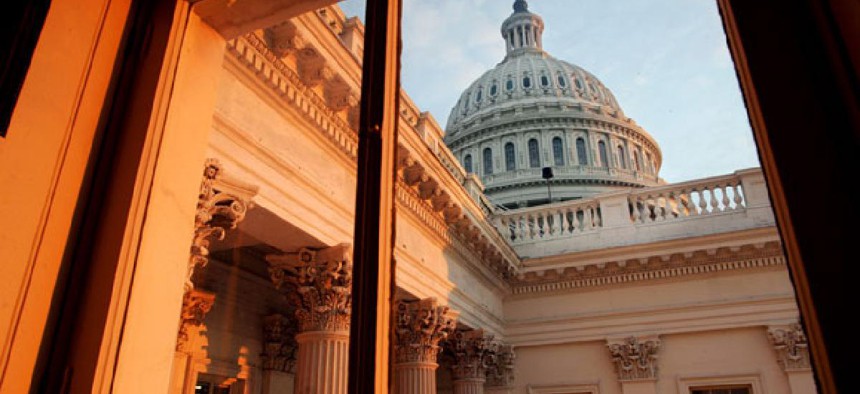
Evan Vucci/AP file photo
Capitol poses serious obstacles for people with disabilities
The sidewalks of the Capitol complex alone challenge disabled visitors.
Forget navigating the hallways or figuring out which elevator to use. For a visitor to the U.S. Capitol with limited mobility, just approaching a House office building is a barrier-riddled nightmare.
From too-steep curb ramps to uneven grades, the sidewalks of the Capitol complex alone present a host of barriers for visitors with disabilities. Despite bipartisan awareness and agreement to address the problems, funding isn’t sufficient for repairing barriers—or even to pay for the inspections necessary to identify them. Congressional contractors aren't required to make sure their plans comply with accessibility regulations before they break ground, so they may be adding more barriers as they work to fix existing ones.
In a report to be released on Thursday, an advance copy of which was provided to National Journal, Congress's Office of Compliance details a host of accessibility barriers on the Capitol campus. Its initial survey of House-side sidewalks revealed 154 barriers, more than half of which pose a safety risk for people with disabilities. Ninety-three percent of curb ramps outside the three House buildings, for example, do not comply with the 1990 Americans With Disabilities Act, which, among other things, set legal requirements for building accessibility. Many of the barriers identified on the Capitol campus were erected after the ADA passed and after the law was applied to legislative branch buildings in 1995.
The office also took special interest in surveying Capitol restrooms after receiving specific complaints about bathroom accessibility. The OOC inspected one restroom in each of the Senate and House office buildings—none complied with the ADA. In the Cannon House Office Building, the bathroom was not wide enough for easy wheelchair access; in most bathrooms, door handles, soap dispensers, and handrails were not designed or installed for use by those with disabilities.
Though the OOC must assess accessibility biennially, new software made a more specific inspection process possible last year. Because the agency's resources are limited, however, the OOC did not investigate any individual House or Senate offices. It also did not explore the interiors of the Capitol itself or the Library of Congress, even though all those structures legally must comply with the ADA.
Fixing the barriers it did identify would cost $1.4 million, according to the office's estimates. Upgrades include simple solutions, such as installing new bathroom handrails, as well as more complicated fixes, such as regrading curb ramps. The Architect of the Capitol, which would oversee the work, did not provide the OOC with its own cost estimates in time for the report’s release.
The Capitol and its campus are not under the jurisdiction of the Justice Department, which enforces ADA compliance. If it were, DOJ could seek civil penalties of up to $100,000 for some violations. Parties filing complaints with the Justice Department could also seek damages, according to Jonathan Mook, a disability lawyer and ADA expert.
But there is no one with executive authority to ensure that the Architect of the Capitol or its contractors comply with the ADA. The OOC has no power to force the AOC to address problems unless a member of the public files an official complaint with the Compliance Office.
Disability-rights advocates put their concerns in stark terms: An estimated one in five Americans is living with a disability. That 20 percent of the taxpaying public deserves access to their representatives in government, they argue.
“The ADA was passed 22 years ago. This is something the rest of the country is held accountable to, and Congress needs to be as well,” said United Cerebral Palsy's Kaelan Richards. “I don’t think the cost estimates in this were enormous, as compared to other government expenditures. It’s a matter of access. When you get down to the bottom of this, this is a constitutional right we’re talking about.”
Others close to the fight for access to Capitol Hill, however, say the Capitol is far more accessible than it was just 10 years ago. Heavy doors have been replaced with lighter ones and many have automatic openers; ramps and curb cuts were added to sidewalks. More than 260 elevators were modernized to meet ADA standards. The House installed lifts to the speaker's rostrum in 2010.
Rep. Jim Langevin, D-R.I., a quadriplegic and the House's first wheelchair-bound member, first presided over the House when that lift was finished. He applauded efforts in the last decade to make the Capitol accessible.
“Are there some things that still need to be changed, like making sure restrooms are more accessible? Sure. More work still needs to be done,” he said. But “I’m very grateful and very pleased with the progress I’ve seen. It happened too slowly, but we are getting there.”
Republicans, Democrats, and the AOC all agree on the importance of future improvements but the legislative budget is tight. Making the Capitol more accessible is no simple task either. Renovating historic buildings is an especially complicated and costly endeavor; celebrated, untouchable facades and wide expanses of marble can send renovation costs skyrocketing.
Read the rest of this article at NationalJournal.com.
NEXT STORY: What is Innovation in Government?






